Roman ruins come in all sizes and shapes, from the majestic to the humble. Some stand barely untouched by the ages, while others are dilapidated remains of their former grand selves. But all provide a wondrous snapshot into Roman civilization: the gods they venerated, their architectural prowess, the entertainment that thrilled them, and the decorations and amenities in their homes.
And yet, it’s Rome, with its mega Coliseum, Forum and Pantheon, that’s seen as the epicenter of all ancient Roman antiquities. Sure, it was the capital of the Empire, but the Romans spread their wings across large swaths of Europe, southern Britain, North Africa and the Mid-East. These are 10 of the best places to check out what they left behind outside of Italy.
[social]
1. Merida, Spain
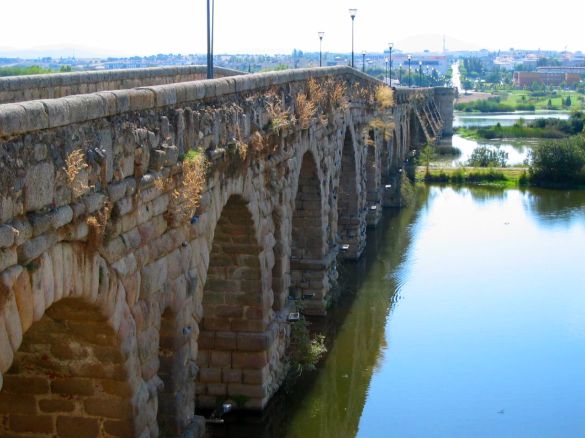
Ruins seem to materialize in the unlikeliest places in this former capital of the Roman province of Lusitania. The Temple of Diana appears behind the tourist information office, and the colorful Los Milagros Aqueduct with its seven standing columns rising not far from a set of railroad tracks.
Stroll along the nearby leafy landscaped expanse that fronts the Guadiana River and you’ll come upon a half-mile long Roman bridge, the longest such structure remaining in the world. This now pedestrian structure that attracts joggers and cyclists alike is within striking distance of its contemporary cousin that’s designed by star architect Santiago Calatrava. Another place to walk among history is along the periphery of the Roman Circus where charioteers once raced.
But anyone who thrills in the macabre should check out Los Columbarios funeral site. Aside from providing a wealth of information on Roman funeral ceremonies, it’s planted with an array of flora, such as cypress, that symbolically refers to death and the afterlife. For intimate insights into all things Roman, take a guided tour with Marco Mangut.
>> Look for cheap flights to Spain and read about more Roman ruins in Spain
2. Leptis Magna, Libya
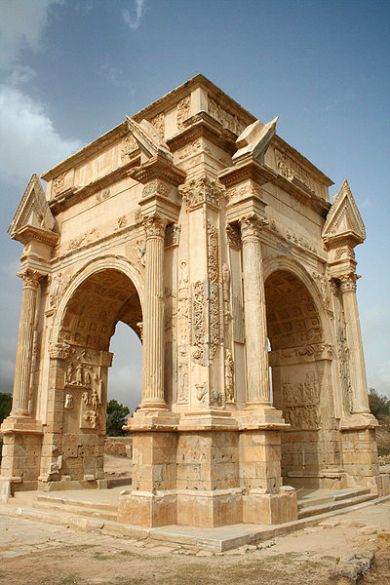
Your introduction to the extravagant architecture in this city that was once held in as high esteem as Rome is the grand Septimius Severus Arch. Named in honor of their native son emperor who presided over this Roman settlement — the largest in North Africa — during the height of its prosperity, the towering marble edifice is bedecked with elaborate historical and religious motifs.
Walking along the colonnaded street that Severus constructed, you’ll come to the expansive Hadrianic Baths where, thanks to hot and cold rooms, saunas, a swimming pool and marble latrines, the populace probably had plenty of opportunity to luxuriate. The Romans obviously loved their leisure aquatic centers: A long trek brings you to the Hunting Baths with its well-preserved colorful mosaics and frescoes for which it takes its name.
You can spend a good part of a day on the site, but don’t miss visiting Sabrantha, another well-preserved Roman site, that’s a few hours away. Libya Expeditions offers tours that cover both of these Roman sites.
>> Find flights to Libya and look for hotels in Libya
3. Pula, Croatia

You could easily spend four or five hours in Pula where the immense amphitheater dating from the time of Augustus gets all the attention.
With an audio guide in hand, you can roam around the well-preserved arena, tiers, towers and subterranean galleries and visualize the gory entertainment that once captured spectators’ attention. (Present-day events include the decidedly more civilized Pula Film Festival.) The underground corridors that once held beasts and gladiators alike now display stone olive and grape presses and amphora.
A steep walk up to the town’s informal Archaeological Museum of Istria is worth it for its Roman glass exhibit, tombstones and sarcophagi. (Curiously, the latter two are displayed along the hallways.)
Another side of Roman life is evident on the largest island of Brijuni National Park, an idyllic setting that’s a short bus and ferry ride away. What must’ve been an elegant Roman villa is set on a prime piece of waterfront real estate complete with ruins of terraces, temples and even a fishpond.
>> Find airfare to Zagreb or read about ferries in Croatia
4. Jerash, Jordan
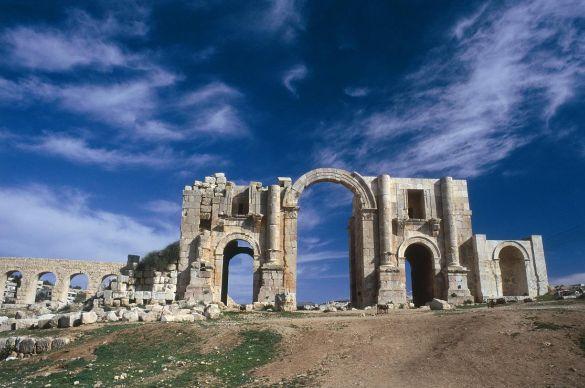
Set in a placid valley at the base of the Gilead Mountains, Jerash contains such an extensive expanse of ruins that you’ll need to reserve a full day for your visit. And though it’s got a petite hippodrome, you’ll be able to watch daily reenactments of what spectators would’ve experienced thousands of years ago.
Gladiators fight wielding tridents and swords. Roman legionnaires decked out in brown togas reenact battles they might have seen as members of a Roman army. And charioteers race the traditional seven laps around the track.
Running under a mile straight to the city center, the Cardo Maximus — Cardo for short — is the colonnaded main boulevard that allows entrée to many monument ruins. (It itself remains paved with some original stones that are rutted from the many chariot wheels that once rolled across its surface.)
>> Find airfare to Amman or book an adventure tour in Jordan
5. Caesarea, Israel

Now a national park, Caesarea was once a resplendent port city that King Herod named hoping to showcase his loyalty to Julia Caesar. Once Jerusalem fell, it became the country’s most prominent city and trade harbor.
The visitor’s center today shows a movie depicting the history of the magnificent city and allows you to ask questions of virtual historical figures. But on a warm, sunny day you have plenty of other choices, whether it’s inspecting the ruins of Herod’s palace, which may have also been used by Pontius Pilot; lunching along the harbor where some of the original stone breakwater remains; or snorkeling or scuba diving in the submerged port (now an underwater archaeological park). Depending on your skill and the route, you’ll spy a Herodian pavement or a late Roman shipwreck.
>> Search airfare to Tel Aviv or find a hostel in Jerusalem
6. Aspendos, Turkey
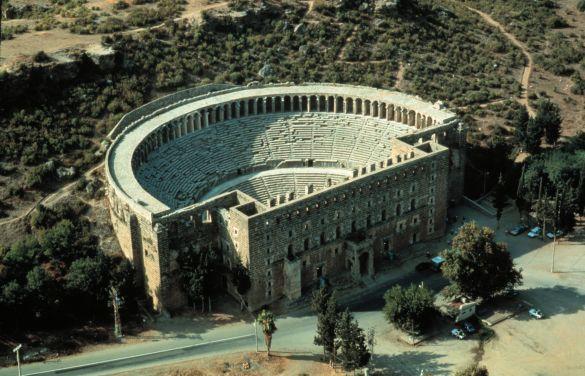
Sweeping down from the hillside, the 2,000-year-old amphitheater has such fine acoustics that some people return year after year to hear Verdi’s Aida, a signature piece, and other works by both Turkish and international performers at the annual Aspendos Opera & Ballet Festival. Equally interesting to many is the stage building displaying ornamental motifs and a decorative relief of Dionysus, the patron god of wine and the theater.
You’ll also want to take the time to walk the path adjacent to the theater that winds up to the acropolis. Not only are the views over the Koprucay River and the fertile Pamphylian plain superb, but a mélange of prominent ruins are also visible, including the agora or ancient marketplace and political gathering spot, a once elaborate fountain complex dedicated to the water nymphs (hence the name nymphaeum), and a basilica where the courts were located. Equinox Travel offers archeological tours that include Aspendos.
>> Find flights to Istanbul and search for hostels in Turkey
7. Baalbek, Lebanon
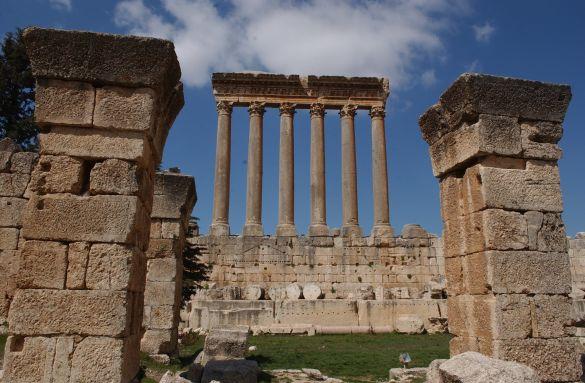
Once known as Heliopolis or City of the Sun, Baalbek has a standout complex of shrines, including two lofty and detailed temples.
The grand one dedicated to Juniper, the god of the sky, is constructed of some of the tallest columns in the world — they soar some 70 feet skyward. The interior sanctuary was once restricted to the priests who performed ritual sacrifices on the stone altar. The massive foundation blocks that weigh in at hundreds of tons remain shrouded in mystery. (It’s still unclear how these stones could’ve been moved.)
The smaller but better preserved Temple of Bacchus is really dedicated not to Dionysus (aka Bacchus) but to a different, much disputed deity: perhaps a solar god. Some believe that the curious carved images of poppies and grapes may indicate that wine and drugs played a role in ceremonies. Hence, the god of wine became identified with this temple.
Nowadays, both temples see theatrical, ballet, jazz and other performances during the annual Baalbeck International Festival.
>> Find air tickets to Beirut and book cheap hotels in Lebanon
8. Conimbriga, Portugal
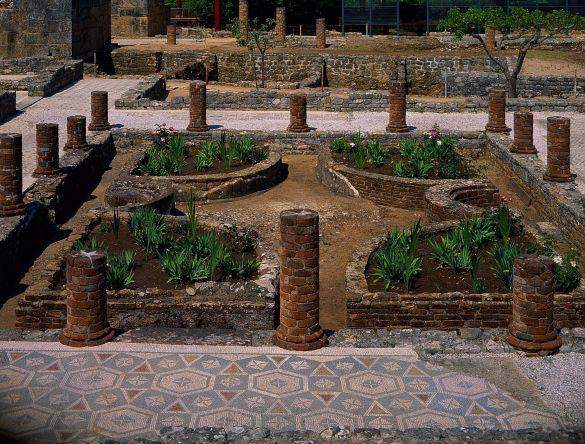
A mere 10 miles from the university town of Coimbra that’s also Portugal’s former capital, you can find the most well-preserved Roman settlement in the country. (In fact, it was a finalist as one of Portugal’s Seven Wonders.)
To get the most out of your visit to Conimbriga where most of the information is in Portuguese, first buy a guidebook at the ticket office. Then roam along the 13-foot-wide limestone-block Roman road where the ruts left by ancient carts are still plainly visible.
The most striking thing about the ruins of the houses along the way is the evidence of their former courtyards with richly-hued mosaics displaying all manner of images — some mythological — and bold geometric patterns. The House of the Fountains, a former wealthy Roman residence, is aptly named for the hundreds of fountains that once gushed. (You can still see the functioning waterworks under the now glass-canopied site.)
Nearby, the remains of the House of Cantaber, a nobleman’s house that’s considered one of the largest Roman residences ever discovered in the West, provides evidence of some of the villa’s luxe features, including its baths and colonnaded garden.
>> Find flights to Portugal and read about what to drink in Portugal
9. El-Jem, Tunisia
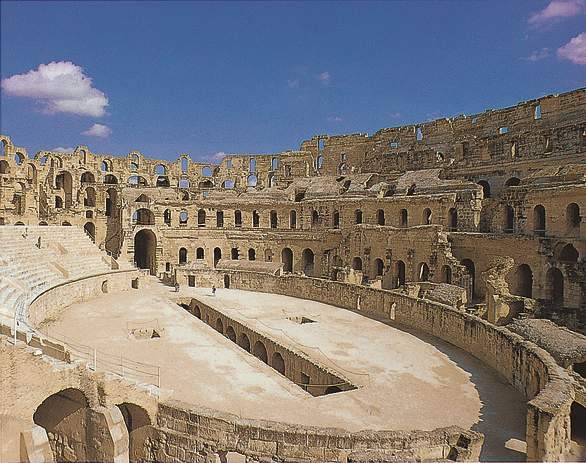
You can’t miss the monumental amphitheater, one of the largest in the Roman Empire that towers over the modern-day city. But instead of rushing to this behemoth — it’s estimated to hold some 30,000 spectators — first pay a visit to the El Jem Museum that displays its impressive collection of artifacts in a reconstruction of a Roman villa.
The exhibits of goblets, sculptures (like Medusa’s head) and mosaics (such as the Nine Muses) ring a colonnaded courtyard. On this archeological site, the lavish House of Africa, an aristocrat’s villa, depicts a renowned mosaic of the goddess Africa, patron of fertility and wealth.
In the summer, you can join the thousands who come to listen to classical — both European and Arabic — music in the grand amphitheater during the month-long International Festival of Symphonic Music. However, it’s hardly the only amphitheater in town. (It’s actually the third built in El-Jem; the ruins of the other two lie near a railroad line.)
>> Find airfare to Tunisia
10. Arles, France
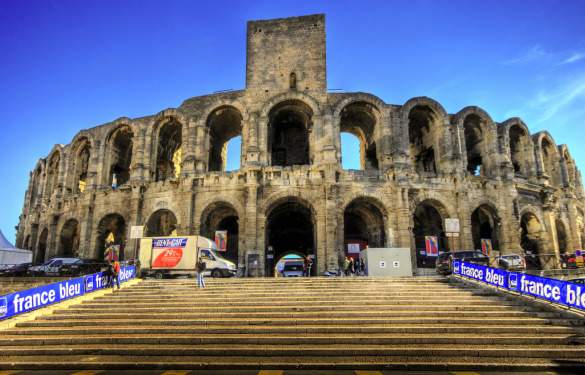
Sometimes referred to as the “Rome of France,” Arles, part of the Marseille-Provence region that will be European Cultural Capital 2013, is dotted with a good share of antiquities. No wonder, considering it’s sited on a trade route that once connected Italy and Spain. And long before Van Gogh fell in love with this evocative land, Emperor Constantine constructed a colossal palace, complete with extensive baths. Partial ruins of these, the Thermes de Constantine, still remain.
Once the social and political hub of this former Roman settlement, the cafe- and tree-lined Place du Forum is still the focal point of the city’s nightlife. A couple of columns from a 2nd century Roman temple are embedded in the exterior of the Grand Hotel Nord-Pinus that fronts this lively square.
But it’s Arles’ massive arch-ribboned amphitheater (Les Arenes) that’s the heart of any visit to this old city. Instead of the ubiquitous Roman blood sports, contemporary spectators can see traditional bullfights — obviously bloody in their own right — or the courses camarguaises where the bulls don’t meet their demise as the men (raseteurs) try to skillfully remove ribbons from the animal’s horns.
>> Find flights to France and discover more day trips from Marseille
Travel back in time with these other history-related articles:
- 5 Places to Rediscover the Golden Age of Piracy
- 6 of the Least Visited Ruins in the World
- 11 World War II Sites to Visit in England and France
photo credits: Baalbek – Baalbeck International Festival; Aspendos – Turkish Culture & Tourist Office; Caesarea – asr-cascadian; Conimbriga – ARPT Centro de Portugal; Jordan – Jordan Tourism Board North America; Merida – a rancid amoeba; Pula – cesargp; Arles – Wolfgang Staudt